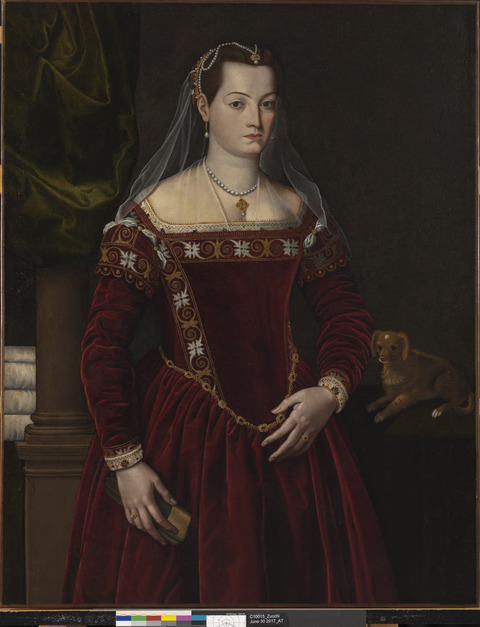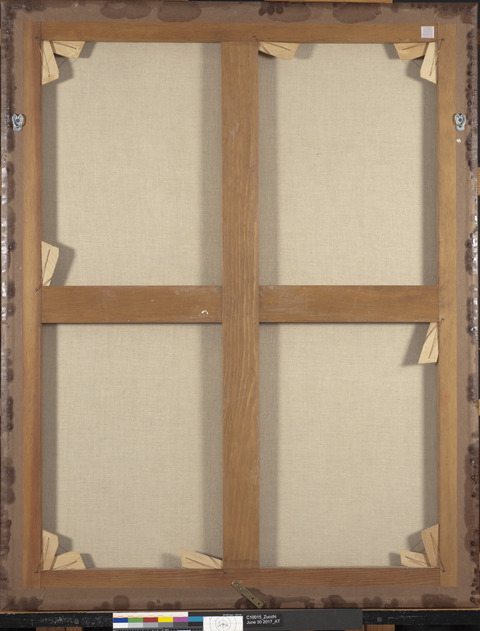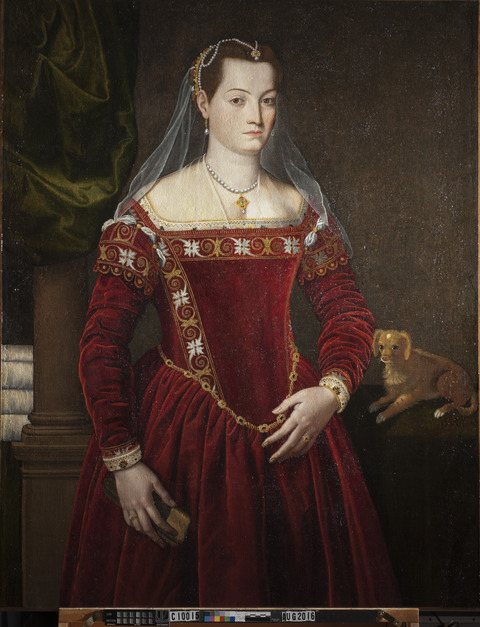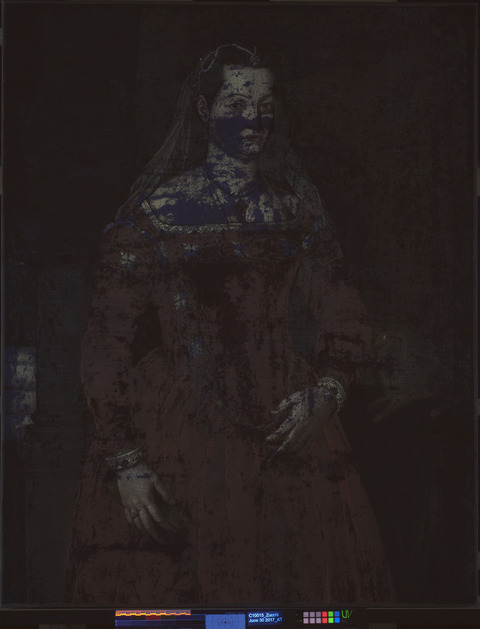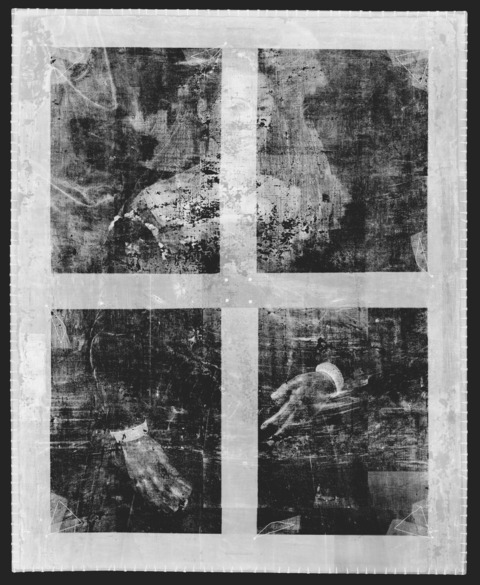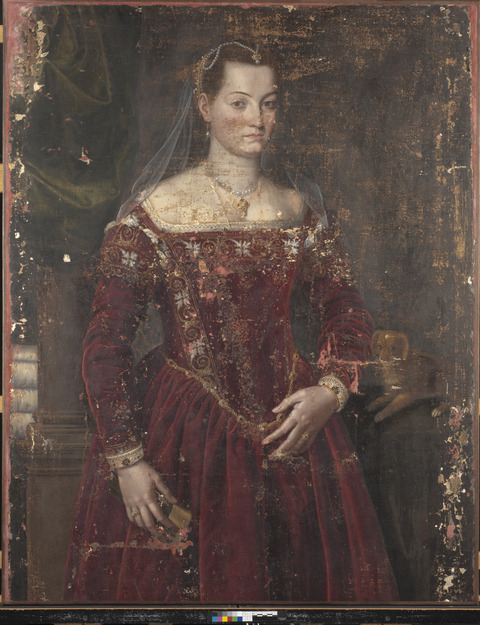Overview
Accession number: 2016.162
Artist: Circle of Agnolo Bronzino
Title: Portrait of a Lady
Materials: Oil (untested) on canvas
Date of creation: About 1540–1550
Previous number/accession number: C10015
Dimensions: 122.4 × 96.5 cm
Conservator/examiner: Fiona Beckett
Examination completed: 2014, revised 2019
Distinguishing Marks
Front:
None
Back:
None
Summary of Treatment History
The painting has likely undergone several conservation campaigns over the course of its existence. The painting is lined with a stiff glue lining, most likely a late nineteenth-century treatment. It appears to have suffered extensively as evidenced by considerable hard-edged losses (possibly from water damage) in both the paint and the ground. These areas were subsequently filled and retouched by restorers during conservation interventions.
Documentation suggests a series of condition assessments and treatments were carried out on the collection around the time the works were moved from the Clowes residence to the IMA in 1971. A condition report by Paul Spheeris in October of that year, likely carried out before the paintings were relocated, described the painting as “O.K.” He did not recommended treatment.1 A second condition assessment was carried out upon arrival of the paintings at the IMA. This assessment describes the work as in good condition, and no treatment was deemed necessary.2
A more recent conservation campaign was carried out by Clowes Conservator of Paintings Fiona Beckett from 2014 to 2017. The natural resin varnish was removed, and the large losses were adjusted and more delicately inpainted using PVA (AYAA: AYAC, 2:1) and stable dry pigments.
The condition of the painting was documented as part of the Clowes Collection annual survey in 2011 and 2019.
Current Condition Summary
Aesthetically, the painting is in good condition, having been recently conserved. The varnish layer adequately saturates the paint layers. Structurally, the painting is in good condition with older interventions still sound. The painting does not require any additional treatment at this time.
Methods of Examination, Imaging, and Analysis
| Examination/Imaging | Analysis (no sample required) | Analysis (sample required) |
|---|---|---|
| Unaided eye | Dendrochronology | Microchemical analysis |
| Optical microscopy | Wood identification | Fiber ID |
| Incident light | Microchemical analysis | Cross-section sampling |
| Raking light | Thread count analysis | Dispersed pigment sample |
| Reflected/specular light | X-ray fluorescence spectroscopy (XRF) | Fourier-transform infrared spectroscopy (FTIR) |
| Transmitted light | Macro X-ray fluorescence scanning (MA-XRF) | Raman microspectroscopy |
| Ultraviolet-induced visible fluorescence (UV) | ||
| Infrared reflectography (IRR) | Gas chromatography–mass spectrometry (GC-MS) | |
| Infrared transmittography (IRT) | Scanning electron microscope -energy dispersive X-ray spectroscopy (SEM-EDS) | |
| Infrared luminescence | Other: | |
| X-radiography |
Technical Examination
Description of Support
Analyzed Observed
Material Type (fabric, wood, metal, dendrochronology results, fiber ID information, etc.):
The canvas is a medium-weight, evenly woven linen. The even weave is somewhat unusual, as many sixteenth-century canvases tend to have coarse and irregular weaves.
Characteristics of Construction/Fabrication (cusping, beveled edges of panels, seams or joins, battens):
The original tacking margins have been removed, and the cusping pattern suggests that the painting plane may have also been trimmed to some extent during this intervention. Slight cusping from a previous stretching is present along the top and bottom edges of the canvas. However, most of the cusped area of the canvas has been trimmed. This is noticeable in the X-radiograph. No previous tacking holes, seams, or irregularities are present. The sitter’s head is quite close to the upper limits of the painting’s edge (8.5 cm from top edge). Brown paper tape is visible around all four edges obscuring the tacks.
Thickness (for panels or boards):
N/A
Production/Dealer’s Marks:
None
Weave (structure, weight, thread thickness, etc):
The original canvas, as seen from the X-radiograph, is a plain-weave, medium-weight canvas with a thread count of 20 threads/cm in the vertical orientation (likely the warp due to the greater amount of threads), and 16 threads/cm in the horizontal orientation (tech. fig. 1). The threads themselves vary slightly in size but are regularly woven. The lining canvas is finer and more densely woven linen. The painting exhibits some of the weave pattern from the original canvas through the paint layer, as well as an additional weave pattern from the lining canvas, characteristic of weave interference.
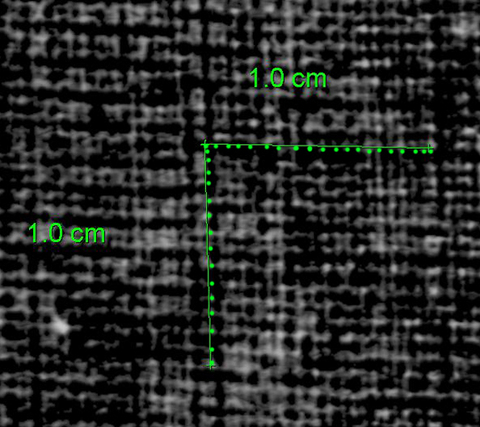
Auxiliary Support:
Original Not original Not able to discern None
The auxiliary support is a six-member stretcher with one vertical crossbar, one horizontal crossbar, and 12 stretcher keys. The members are joined at the corners with mortise and tenon, and the four outer stretcher bars are beveled. The crossbars measure 7.5 cm in width. The cross joint is a lap joint. The clearance from the back of the painting to the crossbars is 1.0 cm. The keys are secured to the stretcher with thin copper wire wrapped around nails near each key. The construction and condition of the stretcher indicates it is a relatively recent addition to the painting and not original. The painting was restretched to the current stretcher during its most recent lining, which appears to be a late nineteenth-century animal-glue lining. The resulting canvas is very rigid. It is possible that this was not the painting’s first lining, given its age and condition.
Attachment to Auxiliary Support:
The painting on its lining canvas is attached to the stretcher with somewhat regularly spaced tacks and thick brown paper tape around all edges so that the tacking margins of the lining canvas are not visible. No original tacking margins exist, as evident from the X-radiograph. No canvas stamps or any additional markings are present on the lining canvas. All 12 keys are present.
Condition of Support
The lining canvas obscures the original canvas from the back of the painting. The X-radiograph reveals that the original canvas appears to be intact and relatively tightly woven. Many areas of damage to the ground layer can be seen, and although the canvas has been trimmed, it does not exhibit any major losses. The original tacking margins have been entirely cut off, likely during the lining process (tech. figs. 2–4).
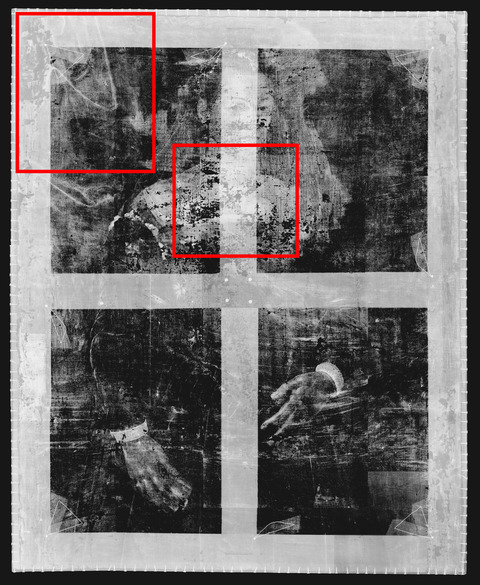
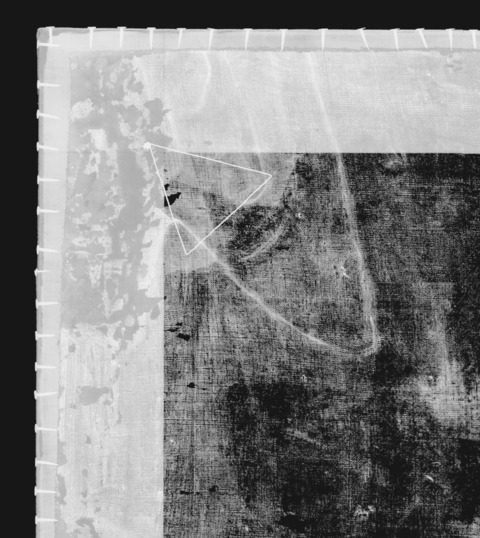
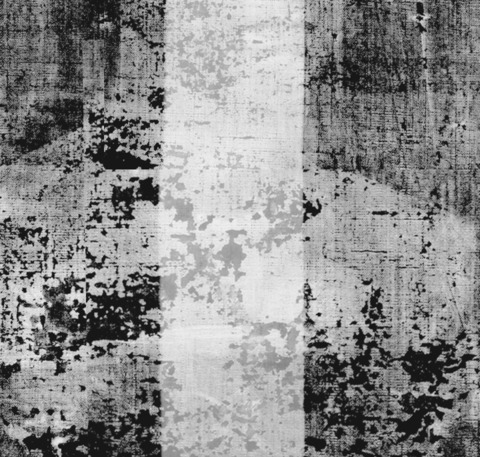
Description of Ground:
Analyzed Observed
Materials/Binding Medium:
The painting has a double preparation layer, and the binding medium appears to be oil-based, due to the thin application and flexibility necessary for a canvas painting, although the medium was not analyzed. The first preparation layer is a light-colored ground and was applied evenly across that canvas. The second preparation layer appears over part, if not all, of the painting and contains a thin wash of red pigments, likely earth pigments, which was uncommon during this period.
Color:
The initial ground layer is an off-white priming layer applied directly over the sized canvas; the imprimatura is a red wash applied over the first ground layer to provide luminance and depth to the painting’s appearance and is particularly useful to help the artist establish midtones. During the course of conservation treatment, both red and white fills were applied to areas of loss. The red ground can be seen in many areas of the painting, particularly where the uppermost paint layers have been thinly painted. The white ground can be seen in areas of loss (tech. fig. 5).
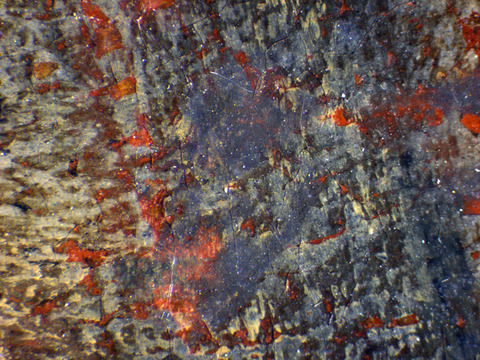
Application:
Lines from the application of the ground are visible in the X-radiograph and perhaps indicate that the ground was spread over the canvas with a palette knife.
Thickness:
Currently unknown
Sizing:
Sizing was likely applied directly onto the bare canvas before the application of the ground, as would have been typical for a painting of this period.
Character and Appearance (Does texture of support remain detectable/prominent?):
The ground layer appears to be thinly and evenly applied over the surface, leaving the canvas weave noticeable throughout the composition. As previously noted, there is weave interference from the lining canvas that has created a more pronounced weave pattern on the face of the painting.
Condition of Ground
Where visible, the ground appears to be in stable condition. There are several small areas around the perimeter where the painting was in contact with the frame that are abraded. Both the paint and ground in these areas were subsequently scraped. No stretcher bars marks are noticeable. The X-radiograph reveals significant areas of loss to the original ground, possibly related to previous water damage or folding/rolling of the canvas. These areas were subsequently filled during treatment campaigns.
Description of Composition Planning
Methods of Analysis:
Surface observation (unaided or with magnification)
Infrared reflectography (IRR)
X-radiography
Analysis Parameters:
| X-radiography equipment | GE Inspection Technologies Type: ERESCO 200MFR 3.1, Tube S/N: MIR 201E 58-2812, EN 12543: 1.0mm, Filter: 0.8mm Be + 2mm Al |
|---|---|
| mA: | 3 |
| Exposure time (s) | 150 |
| Distance from X-ray tube: | 36″ |
| IRR equipment and wavelength | Opus Instruments Osiris A1 infrared camera with InGaAs array detector operating at a wavelength of 0.9-1.7µm. |
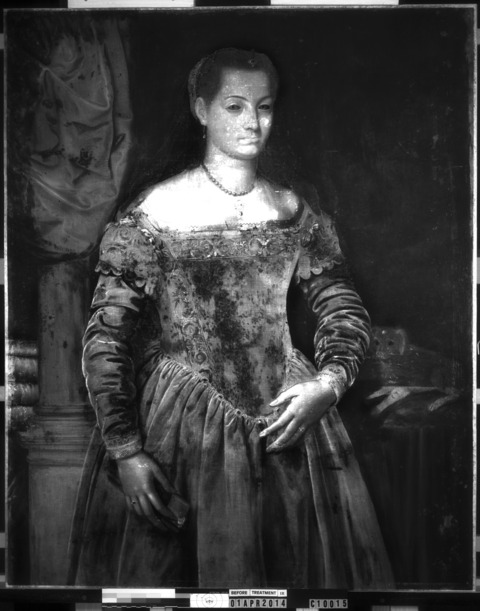
Medium/Technique:
Very little underdrawing was revealed when the painting was imaged using infrared reflectography (tech. fig. 6). It is possible that the material is invisible due to the transparency of the drawing medium, such as red or brown chalk, which contain little carbon. There is slight outlining around the fingers in black paint, which is more visible in the infrared reflectogram (tech. fig. 7) but is also discernible via regular observation. Here, the shapes of the fingers were slightly adjusted before the composition was finished. The outlines and adjustments appear to be done with a carbon-containing paint. The image of the dog at the figure’s proper left was painted after the background was already established; as a result, the reflected infrared image shows a line from the background bisecting the dog lengthwise. No gridlines or any other obvious forms of design transfer are visible.
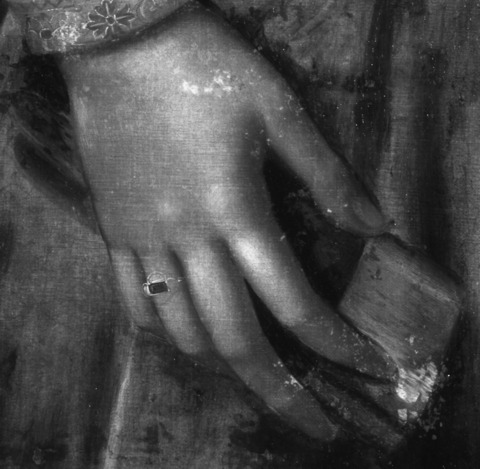
Pentimenti:
None visible
Description of Paint
Analyzed Observed
Application and Technique:
The paint has been applied in a precise and well-blended manner, with emphasis placed on little embellishments in the woman’s dress and jewelry. The background is painted in a deep olive-green color. The precise application of the paint and the sitter’s quiet setting contribute to the painting’s formal mood. The tonal changes in the skin and sheer fabrics are delicate and applied using small brush strokes (tech. fig. 8). A dog was carefully painted to the woman’s side (proper left) after the background was already established. The paint layers were applied both wet-in-wet and wet-over-dry in a paste-vehicular fashion.
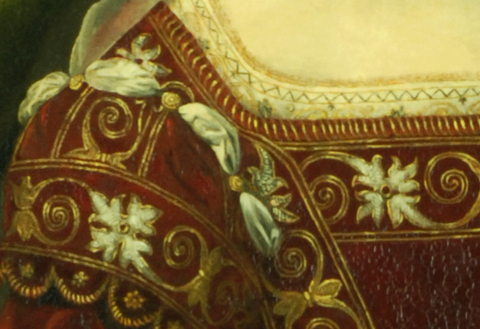
The woman’s head is quite close to the upper edge of the painting, and it is possible that the painting was trimmed, either during a treatment campaign or to fit a frame (see Description of Support). The original tacking margins were removed entirely as was possibly a bit of the composition along the edges. Despite this, it is unlikely that the painting was much larger, as the composition appears complete and most of the stylistic elements are centered on the woman, not the background. One exception is the dog. Part of the dog may have been trimmed, and it is possible that the painting’s original size would have been slightly larger to incorporate more of the dog’s body.
Painting Tools:
The paint was applied by brushes of varying sizes, with smaller brushes used for the highlights, refinements, and delicate areas, such as the details on the dress and the jewelry.
Binding Media:
The binding media appears to be oil, but this has not been confirmed through analysis.
Color Palette:
The artist used a warm color palette, with lush reds for the woman’s dress and varying shades of green for the background. Lead white was used for the lighter areas and blended in the skin tones of the woman, as can be seen from the X-radiograph. Earth pigments would have also been part of his sixteenth-century Italian palette. See XRF Analysis and Raman microspectroscopy for specific pigments.
Surface Appearance:
The paint is smoothly applied with little impasto. The ornamental features of the dress are well blended and delicately painted to give the illusion of shimmering gold thread and sumptuous velvet. It is possible that some impasto was flattened during the lining campaign(s).
XRF Analysis:
XRF analysis was conducted to determine possible pigments present (tech. fig. 9). The abundance of mercury in locations throughout the painting indicates that vermilion was used not only in the red gems and in the important details of the face but also in the woman’s dress. As vermilion was an expensive pigment, usually reserved for important subject matter, its use throughout the painting reinforces our impressions of the wealth and status of the sitter. Lead was identified throughout the painting and would have been part of every artist’s palette during the sixteenth century in the form of lead white. Lead and tin were detected in the jewelry suggesting the use of lead-tin yellow (confirmed as lead-tin yellow type I using Raman Microspectroscopy). This pigment also belongs to the sixteenth-century palette. Copper was found in the blue gems, indicating that azurite was likely used in this area. Other pigments used include iron oxide earth pigments. Manganese was strongly detected in many areas where iron was also detected, suggesting the widespread use of umber pigments. Effort was made to avoid areas of retouching; however, the painting is heavily restored, and it is likely that trace elements of modern pigments used in retouching remain present on the surface. Traces of titanium were found in several of the readings, either from residual retouching or from impurities naturally found in pigments such as iron oxides.
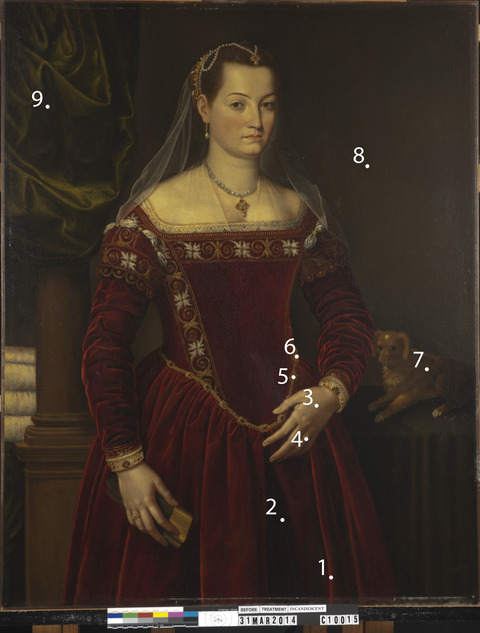
| Sample | Location (x, y) | Elements | Pigments |
|---|---|---|---|
| 1 | Bright red in dress (66.0, 5.0) | Major: Pb, Hg, Ca Minor: Fe, Mn, K Trace: Cu, Ti | Lead white, vermilion, calcium (likely from ground layer), iron-oxide (earth pigments including umber), trace of copper-containing green and/or blue pigment. |
| 2 | Red in dress (60.0) | Major: Pb, Hg, Fe, Ca Minor: Mn, Cu Trace: Ti, Ni | Lead white, vermilion, iron-oxide (earth pigments including umber), calcium (from ground or possible mordant from a red lake pigment), copper-containing green and/or blue pigment, titanium (from impurity or trace of retouching). |
| 3 | Skin tone, proper left hand (64.0, 40.0) | Major: Pb, Hg, Fe Minor: Ca, Mn Trace: Cu, Ti | Lead white, iron-oxide (earth pigments including umber), vermilion, calcium (likely from ground layer), trace of copper-containing green and/or blue pigment |
| 4 | Red gem in ring (61.5, 33.0) | Major: Hg, Pb, Minor: Ca, Fe Trace: Mn, K, Ti | Vermilion, lead white, iron-oxide (earth pigments including umber), calcium (likely from ground layer). |
| 5 | Blue gem in belt (59.0, 46.0) | Major: Cu, Pb, Fe Minor: Ca Trace: K, Mn, Ti | Copper-containing blue pigment, lead white, iron-oxide (earth pigments including umber), calcium (likely from ground layer). |
| 6 | Yellow in belt (58.5, 46.5) | Major: Pb, Sn Minor: Ca Trace: Cu, Fe, Mn | Lead white, lead-tin yellow, trace of copper-containing green and/or blue pigment, trace of iron-oxide (earth pigments including umber), calcium (likely from ground layer). |
| 7 | Brown fur of dog (84.0,47.0) | Major: Fe, Pb, Mn Minor: Ca Trace: Hg, Cu, Ti | Iron-oxide (earth pigments including umber), lead white, calcium (likely from ground layer), trace of vermilion, trace of copper-containing green and/or blue pigment. |
| 8 | Dark green background (72.0, 89.0) | Major: Pb, Fe, Mn Minor: Ca Trace: Ti, K, Cu | Iron-oxide (earth pigments including umber), lead white, calcium (likely from ground layer), trace of copper-containing green and/or blue pigment. |
| 9 | Green in curtains (16.0, 102.0) | Major: Cu, Pb Minor: Ca, Fe Trace: Mn | Copper-containing green and/or blue pigment (likely copper resinate or oleate), lead white, calcium (likely from ground layer), iron-oxide (earth pigments including a trace of umber). |
Table 1: Results of X-ray fluorescence analysis conducted with a Bruker Artax microfocus XRF with rhodium tube, silicon-drift detector, and polycapillary focusing lens (~100μm spot).
*Major, minor, trace quantities are based on XRF signal strength not quantitative analysis
Raman Microspectroscopy:
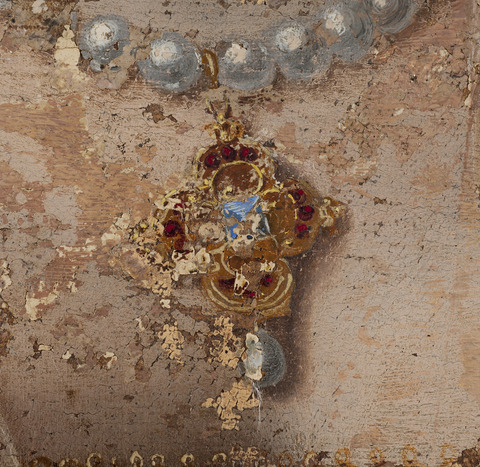
The yellow pigment used in the jewelry was analyzed by Raman microspectroscopy in order to determine what type of lead-tin yellow was employed by the artist (tech. fig. 10). The Raman spectrum indicates the presence of lead-tin yellow type I, which was more frequently used during the sixteenth century than lead-tin yellow type II. As lead-tin yellow type I was most commonly used in the fifteenth through seventeenth centuries, the presence of the pigment confirms the time period of this painting. Massicot (PbO) is also present in the Raman spectrum.3 A sixteenth-century Italian artist would most certainly have lead-tin yellow type I on his palette.
Condition of Paint
A microcracking pattern extends over the entire painting resulting from natural aging. Significant losses of paint and ground layers are present, possibly from water damage, rolling of the canvas, or failed restorations. This is evident in the X-radiograph and the infrared reflectogram. Overall, the original paint layer is in stable condition despite the painting having suffered considerably in the past (tech. fig. 11).
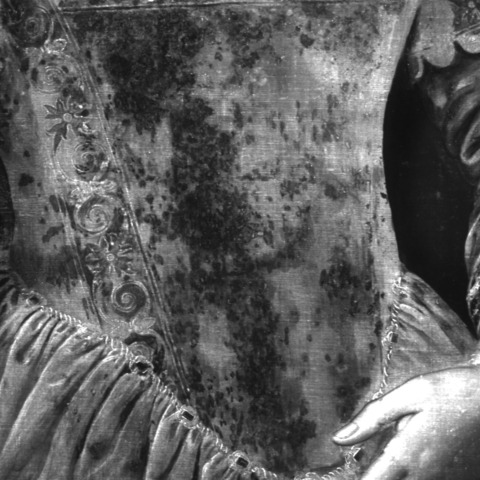
Description of Varnish/Surface Coating
Analyzed Observed Documented
| Type of Varnish | Application |
|---|---|
| Natural resin | Spray applied |
| Synthetic resin/other | Brush applied |
| Multiple Layers observed | Undetermined |
| No coating detected |
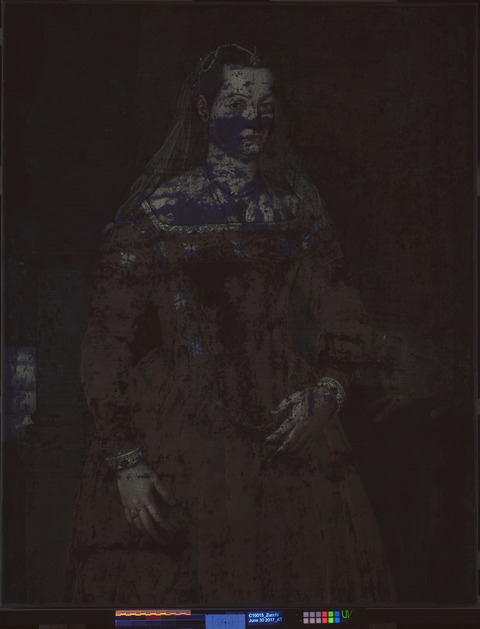
During the 2014 treatment, an isolating layer of a Paraloid B-72 and Laropal A81 mixture was applied to the painting. Fills and inpainting were applied over this layer. Losses were inpainted using stable dry pigments in a PVA medium (AYAA: AYAC, 2:1). A final layer of synthetic MS2A varnish was brush applied to the surface of the painting to saturate the inpainting and provide a protective coating (tech. fig. 12).
Condition of Varnish/Surface Coating
The varnish is in good condition, adequately saturating the paint layers and providing an even sheen over the surface. The inpainting is well saturated and well matched.
Description of Frame
Original/first frame
Period frame
Authenticity cannot be determined at this time/ further art historical research necessary
Reproduction frame (fabricated in the style of)
Replica frame (copy of an existing period frame)
Modern frame
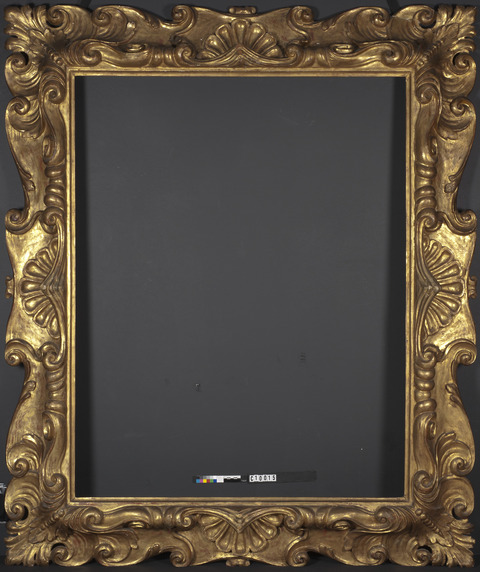
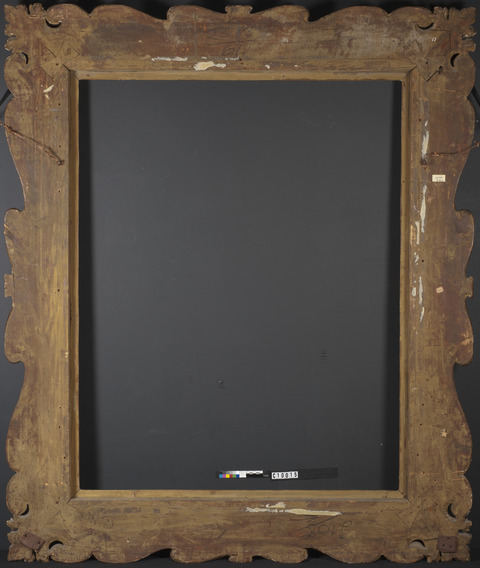
Frame Dimensions:
Outside frame dimensions: 160 × 135 × 10 cm
Sight size: 118 × 93 cm
Distinguishing Marks:
Item 1. Small white paper label with handwritten inscription “TR#10015” on right member of the back of frame (tech. fig. 14).
Item 2. Small white paper label with red border with handwritten inscription “Z202” on right member of the back of frame (tech. fig. 14).
Item 3. Handwritten inscription in black crayon “2518/61” on top member of the back of the frame (tech. fig. 14).
Item 4. Handwritten inscription in white paint “17” in upper-right corner (tech. fig. 14).
Item 5. Handwritten inscription in black crayon “2018/z” (upside down) on lower member of the back of the frame (tech. fig. 14).
Description of Molding/Profile:
The frame originates from Florence and was constructed about 1840 (tech. fig. 13), as per observations by Timothy Newbery. It is constructed from carved poplar, displaying several stylistic elements including scrolled leaves, shells, and knullings with peaks at centers over shells. The frame is symmetrical in appearance. The corners are mitred and joined with butterfly keys (tech. fig. 15). Newbery describes the frame as a “19th century version of Palatina-style frame made for Palazzo Pitti, Firenze for Leopoldo de’Medici. c.1640” with “interestingly very little auricular ornament."4 The frame has water gilding over a red bole layer.
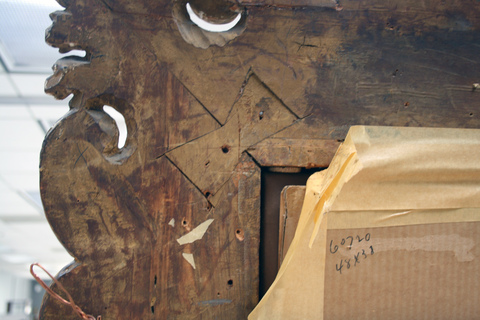
Condition of Frame
The frame is in good condition and was conserved between 2016 and 2019 by Clowes Conservator of Paintings Fiona Beckett, Senior Paintings Conservator Linda Witkowski, and Senior Conservation Technician Laura Mosteller.
Notes
-
Paul A.J. Spheeris, “Conservation Report on the Condition of the Clowes Collection,” 25 October 1971, Conservation Department Files, Indianapolis Museum of Art at Newfields. ↩︎
-
Martin Radecki, Clowes Collection condition assessment, undated (after October 1971), Conservation Department Files, Indianapolis Museum of Art at Newfields. ↩︎
-
R.J.H. Clark, L. Cridland, B.M. Kariuki, K.D.M. Harris, and R. Withnall, “Synthesis, Structural Characterization and Raman Spectroscopy of the Inorganic Pigments Lead Tin Yellow Types I and II and Lead Antimonate Yellow: Their Identification on Medieval Paintings and Manuscripts,” ChemInform 26, no. 47 (21 November 1995): 2577, https://doi.org/10.1002/chin.199547006. ↩︎
-
Timothy Newbery, frame specialist, London, England. Visual analysis completed at the Indianapolis Museum of Art, 19 January 2012. ↩︎
Additional Images
